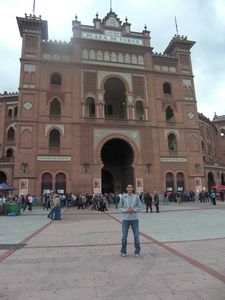Advertisement
Published: October 19th 2010

 In Front of Las Ventas
In Front of Las Ventas
One of the most famous bull fighting rings in the worldOne of the first things that people often think about when you mention Spain, is bull fighting and I had my chance to see a bull fight for the first time on the same day that the national holiday with the parade was. The bull fight took place at Las Ventas which is one of the most famous bull fighting rings in the world. It was also the last bull fight of the 'season' with the professionals. The rest of the bull fights (normally held each Sunday) for the year would be amateurs.
Even in the country that they are most famous, bull fighting is extremely controversial. In the Catalonia region, they have outlawed it as has other countries such as Portugal where bull fights still take place, but they are not allowed to kill the bull. Yet, there are still a large number of people who love and greatly appreciate the tradition. Normally, every Sunday, the fights are sold out a few days in advance and their are even people with season tickets. The good bull fighters (Matadors) are huge celebrities here, make lots of money, and live a very lavish life.
The bull fight we went to
was on a Tuesday and we were surprised to find the ring barely half full. (maybe it was the cold weather). The fight started very much on time with the procession of the people involved in the fight. We had gone to an information session about bull fighting at the school a week before, so we knew a little bit about what to look for and what to expect. A bull fight consists of 3 matadors who each fight two bulls (therefore there are 6 fights all together). With each bull there are three stages that are followed very meticulously. The transition between each stage is signaled by a white flag that is waved by the president who sits in his box over looking the ring. The flag signals the band to make the ceremonial transition sound. With the three rounds and all, each bull fight is only about 15 minutes long.
While I was not sure what to make of the whole spectacle, I thought it was a very cultural experience that I am glad I partook in.... some people could not handle the blood, brutality and all and had to leave. The bulls were huge and it
was impressive watching the toreros handle them so well (only one guy had to ditch and jump over the fence). For us novices, we were not sure of all the technical stuff to watch for, but the crowd knew and was very vocal about when they liked something (clapping and cheers) and when they didn't like something (whistling). Thus, while I enjoyed going, you probably will not find me at another fight in the future.
INTERESTING FACT: The bull, once killed, is taken to the slaughter house they have at the ring, and you can then go and eat the meat after the fight. Because the bulls are raised so well, to eat the meat is REALLY expensive. We opted out of that part of the experience.
Advertisement
Tot: 0.046s; Tpl: 0.014s; cc: 7; qc: 24; dbt: 0.0228s; 1; m:domysql w:travelblog (10.17.0.13); sld: 2;
; mem: 1mb

 In Front of Las Ventas
In Front of Las Ventas




